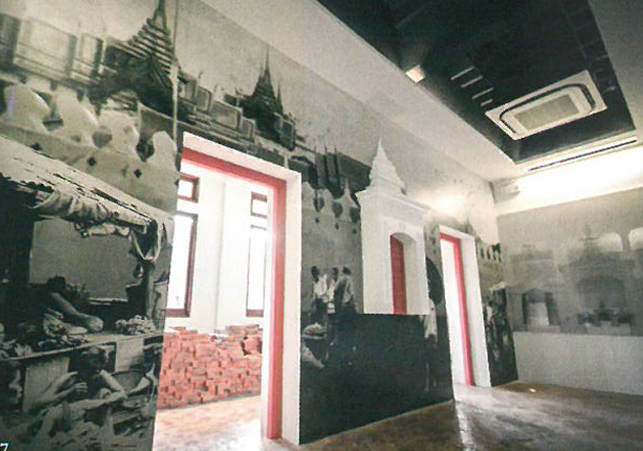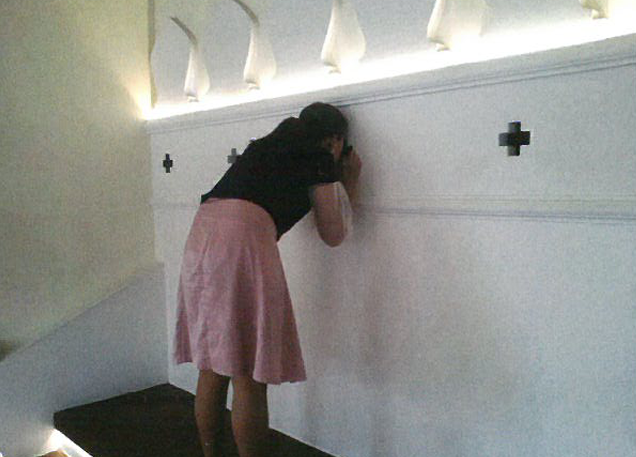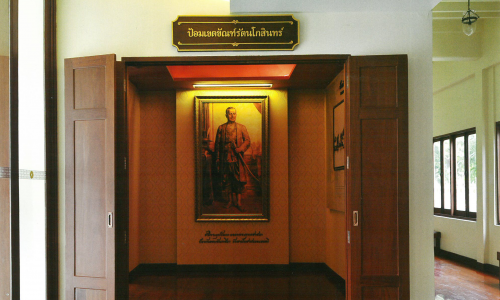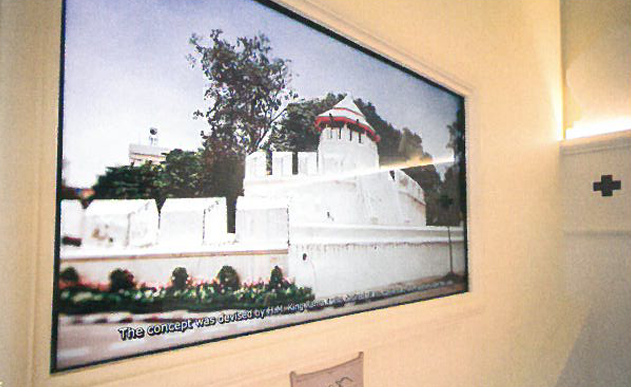An archeological excavation in year 2013 suggested that there was the city wall was one connected to Prasumain fort, situated on the bank of the Chaopraya River, next to the old Kuruspha printing house. When the Treasury Department began to develop Pipitbanglumphu project on location of the old Kuruspha Printing House, it paid special attention to the preservation and dissemination of knowledge about the trail of the city walls, the architectural history of Banglamphu district. This initiative represents valuable heritage that connecting the local and this community since ancient times, With this historical preservation concept bearing in mind, an exhibition called ‘The Forts of Khung Rattanakosin‘was created to commemorate this ancient architectural heritage.

คูคลองล่องลำนำ

|
In the beginning of Krung Rattanakosin, the construction of forts and city walls were important for the purpose of determining the city’s boundaries as well as providing the defense form foreign invasions. Thai had to protect the city form its neighboring countries such as Burma, Laos, and Khmer. These forts and city walls symbolize the strength for the city.
His majesty Phra Phutthayotfa Chulaok Maharaj (King Rama I) drafted 5,000 Laotians from Vientiane to help with the construction of the city walls. Providing the obstacles from numerous warfare and shortage of construction of the city wall would require many years prior to its completion; therefore, these Laotians would settle in the kingdom and became the citizen of Siam. |
ประตูคู่วิถี
After the completion of the city walls Chao Phraya Paskrasuang (Kum Boonak) recorded in the archives that the wall surrounding the city was 7.2 kilometers length, 3.2 meters high, and 2.7 meters thick with a distant of 400 meters between each fort.
ป้อมปภนคา

The city wall at that time had 63 city gates comprising of 14 large entranes as clear evidence big gates and 47 small gates known as ‘Pratu chongkud , These gates were the connection paths between the residents inside city wall and people from the outside. Theses gates, therefor, played an important role in the daily lives of the people at the time such as a meeting point. For example , Pratu Din or Pratu Srisudawong of the royal palace was the door to the inner court and the living quarter of the female courtiers, which all men are prohibited. Men had to wait at the gate to be able see the glimpse of female courtiers, when they left the palace to run an errand. That was the origin of the Thai saying ‘Chaochoo Pratu din’ to tease Thai men for courting the women in the public. Another important gate is ‘Yarn Pratu Phee’ (Ghosts door area), which is the area around Yaksumranraj road at the crossroad between Bumrungmuang road and Mahachai road. During the ancient time the deceased residents were taken out of from the city through this gate. Currently, this area is famous for the street food night market.
กำแพงป้องธนานี

Apart from the city walls, city moats were dug around the city to provide additional layer of defense. These waterways were viable for city in time of war and peace. It facilitated army to transport weapons and troops. Subsequently, it also provided a source of water supply and transportation route for civilians. In the early Rattanakosin period, canals were dug to extend the city eastbound from the Chaopraya River. It began by rooting and clearing the existing canal. The canal near the area of large area covered chiefly with Lumphu trees later named Bang Lumphu canal. The canal was built along many important areas around the city until it intercepted with the Chaopreay River at Wat Sampleam or Wat Bapitpimook. As this canal passed through many important places around the city, it was later know as "Klong Rob Krung” or canal around the city. Not long after, there were 2 more small canals being dug, bridging the old city canal with ‘Klong Rob Krung’. These canals were called "Klong Lord Wat Batchanattda” and ‘Klong Lord Wat Ratchaborpit’. Another canal was also dug near Wat Sakae or Wat Saket called ‘Kiong Mahanark’. This canal became popular as a place to hold a festive singing duel celled ‘Len Pleang Sukawa’ during the annual flooding season, which followed the tradition of Aduyudhaya period.

After the war had subsided, the city continued to prosper with trade and commerce. City walls and forts ceased its purpose. At the same time , the urgent need to expand residential area to accommodate a growing population significantly increased. Therefore, may city walls and forts were torn down. Even though Phar sumanefort wasn’t torn down like other forts, the lack maintenance has made the foundation collapse. In 2006 during the of Rattanakosin city and its important landmarks, Phra sumane fort has the restoration that brought it back to the original glory. Additionally the area surrounding the fort. Which used to cover chiefly with Lumphu tress was fransformed into a park called ‘Suan Santichaiprakarn’ which became a recreation place for the public. As for large Lumphu tree at Suan Santichaiprakarn, the last standing in the Bang Lumphu area, it died standing during the massive flooding in 2011. The Treasury Department and Bang Lumphu community had kept its branch for display in an exhibit at the Pipitbanglamphu in order to preserve the footprint of history for the study of future generations.






